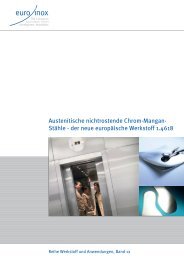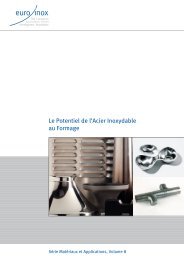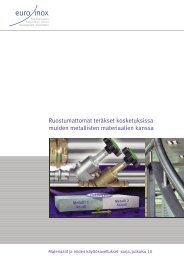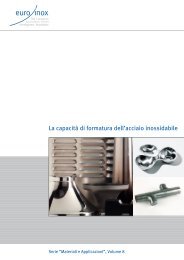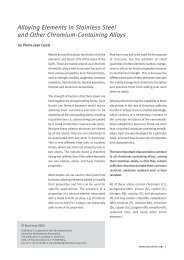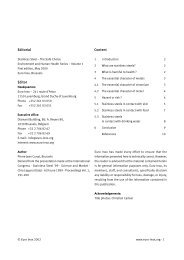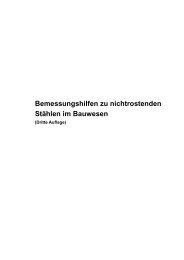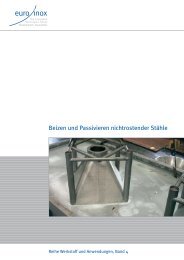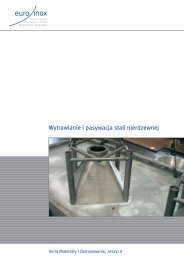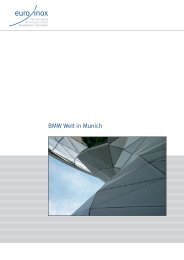Innovative Stainless Steel Applications in transport ... - Euro Inox
Innovative Stainless Steel Applications in transport ... - Euro Inox
Innovative Stainless Steel Applications in transport ... - Euro Inox
Create successful ePaper yourself
Turn your PDF publications into a flip-book with our unique Google optimized e-Paper software.
Reduction factor<br />
1<br />
0.9<br />
0.8<br />
0.7<br />
0.6<br />
0.5<br />
0.4<br />
0.3<br />
0.2<br />
0.1<br />
0<br />
0 100 200 300 400 500 600 700 800 900<br />
Temperature [C]<br />
Steady-state tests, Base mat. Transient state tests, Base mat.<br />
Steady-state tests, RHS-tubes Transient state tests, RHS-tubes<br />
Figure 36. Reduction factors of the yield strength of austenitic sta<strong>in</strong>less steel EN 1.4301,<br />
compar<strong>in</strong>g the results of different methods used to test virg<strong>in</strong> sheet and cold-formed material<br />
(Ala-Out<strong>in</strong>en & Oksanen, 1997).<br />
The strength of a material <strong>in</strong>creases due to cold work<strong>in</strong>g dur<strong>in</strong>g the fabrication process.<br />
The rema<strong>in</strong>s of this <strong>in</strong>creased strength at elevated temperatures can be seen <strong>in</strong> Figure<br />
36. The <strong>in</strong>creased strength due to the cold-form<strong>in</strong>g process rema<strong>in</strong>s more or less<br />
constant up to 600 °C but beyond this po<strong>in</strong>t strength beg<strong>in</strong>s to decrease and the<br />
<strong>in</strong>fluence of cold-form<strong>in</strong>g totally disappears at 900 °C.<br />
S<strong>in</strong>ce the various sta<strong>in</strong>less steel types behave differently, it is reasonable to determ<strong>in</strong>e<br />
the specific reduction factors separately for each type of sta<strong>in</strong>less steel. Furthermore,<br />
both tensile strength and elastic modulus behave similarly to proof strength at elevated<br />
temperatures. However, determ<strong>in</strong><strong>in</strong>g the modulus of elasticity based on the slope of the<br />
stress-stra<strong>in</strong> curve is very <strong>in</strong>accurate, as the proportional limit of austenitic sta<strong>in</strong>less<br />
steel is very low. The least <strong>in</strong>accuracy <strong>in</strong> the measured curves has a very significant<br />
<strong>in</strong>fluence on the calculated modulus of elasticity and the unreliability of modulus-ofelasticity<br />
values determ<strong>in</strong>ed <strong>in</strong> this way is thus quite remarkable.<br />
Table 13 shows the reduction factors of yield strength <strong>in</strong> relation to 0.2 % proof stra<strong>in</strong><br />
for various sta<strong>in</strong>less steel grades and various delivery conditions. Further data on the<br />
fire properties of the various sta<strong>in</strong>less steel grades and forms are given by Ala-Out<strong>in</strong>en<br />
(1996), Ala-Out<strong>in</strong>en et al. (2003), Out<strong>in</strong>en & Mäkelä<strong>in</strong>en (1997) and Baddoo & Burgan<br />
(2008).<br />
47



